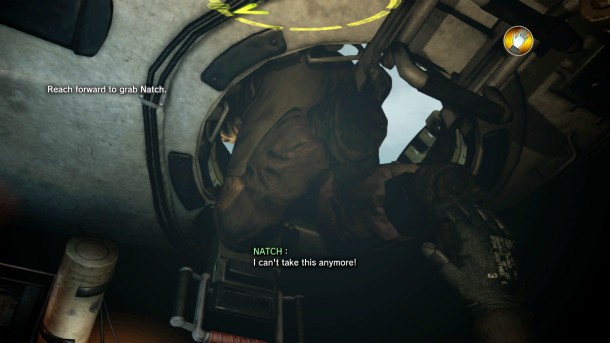Please support Game Informer. Print magazine subscriptions are less than $2 per issue
Steel Battalion: Heavy Armor Review

Steel Battalion: Heavy Armor is as fun as fumbling around for your keys in the dark while being pelted with billiard balls. I can’t remember the last time something has made me as frustrated or left me feeling as completely drained as this game has. It’s a showcase for the worst that Kinect has to offer, where nearly every gesture is either ignored or misinterpreted – often with game-ending repercussions.
Heavy Armor is set in the near future, where electronic devices have been destroyed by silicon-eating microbes. In the ensuing chaos, the Asian Empire takes control of Europe and marches into America. U.S. forces retreat into Mexico, intent on restoring freedom in what they call the second war for independence. Politics aside, the techno-reboot background largely serves as a way to explain why pilots are battling in rivet-covered behemoths with vacuum tubes powering their insides.
The original Steel Battalion is best known for its unique interface. The Xbox game shipped with a dedicated controller peppered with dozens of buttons, which powered everything from startup sequences to windshield wipers to smokescreens. It was incredibly gimmicky, but it was also a fun (and pricey) way to realize your giant-robot-piloting dreams.
Steel Battalion: Heavy Armor takes a different approach, having been developed with Kinect in mind. In other words, Capcom and From Software are sprinting toward the other end of the controller-complexity spectrum. It’s a neat concept, but unfortunately neat concepts can only get you so far.
You don’t play as the VT in the game, so you can allay any fears that you may have about walking in place to make your lumbering machine move forward. You’re the pilot of a four-person crew inside, and you navigate through the world (and your vehicle) using a mix of traditional and motion-based controls. Aside from moving around and firing your weapons, Kinect does most of the heavy lifting. Or it attempts to.
To keep things simple, your cockpit’s interior is divided into a series of panels. For example, on your left is a retractable radar screen. Hover your hand over a button, and you can see several other viewpoints from VT-mounted cameras. On your right side is a panel that lets you turn on your headlights, ventilate the cabin’s interior, and, in a nod to its roots, eject and self-destruct. Unlike its predecessor, you won’t lose your save game if you don’t eject in time. That’s great, because you’d have a tough time hitting that button even if it were the size of a loaf of bread. I’m not exaggerating when I say that Steel Battalion: Heavy Armor has the worst motion controls I’ve ever experienced, on Kinect or anywhere else.
For example, frustration accompanies even simple motions, such as trying to switch between a normal porthole view and precision targeting scope. Supposedly, you move your hands forward in a shoving motion to look out of the VT’s tiny front window, and you raise them above your head to get to the scope. More often than not, when I wanted to look through the porthole to navigate my VT in a firefight, I ended up shuttering the little window – the exact opposite thing that I wanted to accomplish in that situation. My ghostly onscreen hand would hover over the window’s handle, seemingly in contemplation over whether it should pay heed to my arm movements and just open the damned thing. All the while, bullets would ping off my chassis and explosions would draw ever closer. In a similar vein, switching between armor-piercing and explosive rounds rarely works, which is kind of a big deal.

Steel Battalion: Heavy Armor is a technical failure. It’s bound to have its advocates who will undoubtedly make apologies for unresponsive, inaccurate controls. Like any reasonable person, I expect a baseline degree of functionality when I play a game. Just because a game uses Kinect, players shouldn’t dilute their expectations. Nobody would rally around a game that registers a button press 25 percent of the time, and you shouldn’t do so here. Even co-op can't save the game, which breaks the age-old rule that everything is more fun with friends. In this mode, four victims take on waves of enemies and vaguely defined objectives. Each person is in their own VT with their own crew, so you can abandon any hope of being the dedicated reloader. That's just as well.
Capcom has said that this is a difficult game, and it is. But that’s largely because of the horrible controls. Otherwise, it’s a standard mech game, with the same plodding maneuvering and unsatisfying long-range artillery exchanges. A few technical issues mar what’s already an awful experience, such as invisible obstructions blocking your shots and enemy AI that fluctuates wildly from being comically indifferent to insanely talented. It’s not uncommon to go toe-to-toe with another VT and come out unscathed, only to be nearly dismantled by a foot soldier with a rocket launcher moments later.
Heavy Armor does have its share of interesting ideas, including a crew that can get killed in your dilapidated, hole-filled VT. Sometimes it’s from a bullet. Other times it’s from failing a quicktime event. Either way, when that happens, you have to pick up their slack. That means you’ll have to manually reload shells, for instance, which takes time. If it comes to that, however, you’ll probably be destroyed or die from smoke inhalation because you were futilely pawing at the exhaust-fan controls. There are a few clumsy attempts at injecting personality into these shiny automatons, though they fall flat. Characterizations are about as complex as a guy pining about home in a New Yawk accent, being a “fiery Mexican,” or not taking anyone’s crap. I did find myself upset when they died, but that was mostly because I hated having to mime my way through the reloading sequence.
The game features a small amount of vehicular customization, though it’s not as deep as other games in the genre. I understand that the focus is on simulating a specific vehicle, with all of its idiosyncrasies, and it’s actually a pretty great idea. You’ll get to know every nook and cranny of your VT, such as a gaping hole in the hull, which is the subject of a lot of gallows humor throughout the story.
Heavy Armor’s retro-future setting lends itself to a few cool moments, such as a section where your squad has to navigate through a damaged tunnel. If you fire off too many errant shots during battles against the Asian Empire, the tunnel collapses and the mission is over. You’ll travel the globe during the campaign, though these changes of scenery (and the variety of missions, which also include convoy escorts and quiet stretches based on sheer navigation) don’t fundamentally fix Heavy Armor’s fatal flaws. Unlike the original games, there’s a generous checkpoint system that minimizes the annoyances of failing an objective. That’s little consolation.
The mech-combat genre isn’t overflowing with alternatives, but they do exist. Save yourself the aggravation and pick any one of those. You won’t do any worse.





















